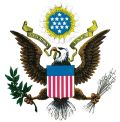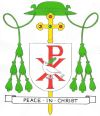364th (Infantry) Regiment, US Army
364TH (INFANTRY) REGIMENT, US ARMY
| (Coat of Arms) |
(Distinctive Unit Insignia) |
Official blazon
Shield: Argent, a fess the middle third metamorphosed into a chevron Sable, in dexter chief a lion rampant of the like, in sinister chief a fleur-de-lis Azure and in base a pine tree Vert.
Crest: That for the regiments and separate battalions of the Army Reserve: From a wreath Argent and Sable, the Lexington Minute Man Proper. The statue of the Minute Man, Captain John Parker (H.H. Kitson, sculptor), stands on the common in Lexington, Massachusetts.
Motto: SEMPER PARATUS (Always Ready).
Distinctive Unit Insignia. Description: A silver color metal and enamel device 1 inch (2.54 cm) in height overall consisting of a shield blazoned: Argent, a fess the middle third metamorphosed into a chevron Sable, in dexter chief a lion rampant of the like, in sinister chief a fleur-de-lis Azure and in base a pine tree Vert.
Origin/meaning
The 364th Infantry was organized at Camp Lewis, Washington, in 1917, as a unit of the 91st Division. It served overseas with this division in the Meuse-Argonne and Ypres-Lys operations and in the sector in Lorraine. After the war the 364th Infantry was disbanded. Under authority of Section 3A, National Defense Act, the 364th Infantry was reconstituted a unit of the 91st Division, Organized Reserves, in November 1921, with headquarters at Los Angeles, California. The fess black is one of the colors of the German flag and represents the enemy line in the Argonne with the salient pushed in by the 91st Division (the 364th Infantry on the right); the fir tree is the insignia of the 91st Division. "At a time when the Divisions on its flanks were faltering and even falling back, the Ninety-first pushed ahead and steadfastly clung to every yard gained", to quote from the order of Major General Geo. H. Cameron, commanding 5th Army Corps on October 3, 1918, when he relieved the 91st Division from front line duty and placed it in reserve. The lion is the black rampant lion of Flanders. The regiment, with the Division, served in Belgium as part of the Army which was to operate in the clearing of Belgium and was known as "The Army for the Liberation of Belgium." The 91st Division History (page 53) says: "The Division detrained at four detraining points and was bivouacked the 18th and 19th of October in the devastated area about Ypres. On arrival the 91st has been placed at the disposition of His Majesty, Albert I, King of the Belgians, commanding the Group of Armies in Flanders. The Army was made up of Belgian, French, British and American troops (91st and 37th)." The fleur-de-lis is blue and represents the service in France proper, in the Argonne offensive.
The arms were originally approved for the 364th Regiment Infantry, Organized Reserves on 11 February 1925. It was redesignated for the 364th Coast Artillery Regiment (AA) on 17 September 1942. On 21 March 1975 the coat of arms was rescinded. On 29 Oct 1998 the Coat of Arms was reinstated and redesignated for the 364th Infantry Regiment. The insignia was redesignated and the description updated on 16 April 1999 for the 364th Regiment. The Distinctive Unit Insignia was originally approved for the 364th Regiment Infantry on 11 February 1925. It was redesignated for the 364th Coast Artillery Regiment (AA) on 30 September 1942. On 21 March 1975 the insignia was rescinded. On 29 October 1998 the insignia was reinstated and redesignated for the 364th Infantry Regiment. The Distinctive Unit Insignia was redesignated and the description updated on 16 April 1999 for the 364th Regiment.
Literature: Images from Wikimedia Commons. Information from The Institute of Heraldry, US Army.
US heraldry portal
This page is part of the US heraldry portal |
Heraldry of the World |
|
US heraldry:
|
Ecclesiastical Heraldry of the USA:
Military Heraldry: |
Contact and Support
Partners:
Your logo here ?
Contact us
© since 1995, Heraldry of the World, Ralf Hartemink 
Index of the site
















